Parathyroid agents are drugs used to treat disorders that affect serum calcium levels. This can be either antihypocalcemic agent or antihypercalcemic agent (further classified into bisphosphonates and calcitonins). The parathyroid glands are four very small groups of glandular tissue located on the back of the thyroid gland. This produce PTH and calcitonin to maintain body’s calcium balance. PTH is the most important regulator of serum calcium levels in the body.
Table of Contents
- Table of Common Drugs and Generic Names
- Disease Spotlight: Parathyroid Dysfunction
- Antihypocalcemic Agents
- Antihypercalcemic Agents
- Practice Quiz: Parathyroid Agents
- Recommended Resources
- See Also
- References and Sources
Table of Common Drugs and Generic Names
Here is a table of commonly encountered parathyroid agents, their generic names, and brand names:
- Antihypocalcemic agents
- calcitriol (Rocaltrol)
- teriparatide (Forteo)
- Antihypercalcemic agents
- bisphosphonates
- alendronate (Fosamax)
- calcitonin
- calcitonin salmon (Miacalcin, Fortical)
- bisphosphonates
Disease Spotlight: Parathyroid Dysfunction
- Parathyroid dysfunction involves either absence of PTH (hypoparathyroidism) or overproduction of PTH (hyperparathyroidism). This can affect any age group.
- Hypoparathyroidism is a rare condition characterized by absence of PTH resulting to low calcium level (hypocalcemia). Accidental removal of parathyroid glands during surgery mostly cause this condition.
- Hyperparathyroidism is a condition characterized by excessive production of PTH leading to elevated calcium level (hypercalcemia). Primary hyperparathyroidism occurs more often in women between 60-70 years of age. Secondary hyperparathyroidism occurs most frequently in patients with chronic renal failure.
- Paget’s disease is a genetically linked disorder characterized by overactive osteoclasts that are eventually replaced by enlarged and softened bony structures. Manifestations include deep bone pain, headaches, and hearing loss.
- Postmenopausal osteoporosis occur when dropping levels of estrogen allow calcium to be pulled out of the bone, resulting in a weakened and honeycombed bone structure.
Antihypocalcemic Agents
- Antihypocalcemic agents are drugs used to treat deficient levels of PTH.
Therapeutic Action
The desired and beneficial action of antihypocalcemic agents:
- a vitamin D compound that regulates the absorption of calcium and phosphate from the small intestine, mineral resorption in bone, and reabsorption of phosphate from renal tubules, increasing the serum calcium level.
- Teriparatide stimulates new bone formation leading to increase in skeletal mass. It increases serum calcium and decreases serum phosphorus.
Indications
Antihypocalcemic agents are indicated for the following medical conditions:
- Management of hypocalcemia in patients on chronic renal dialysis
- Management of hypocalcemia associated with hypoparathyroidism and with sustained systemic glucocorticoids therapy
Pharmacokinetics
Here are the characteristic interactions of antihypocalcemic agents and the body in terms of absorption, distribution, metabolism, and excretion:
| Route | Onset | Peak | Duration |
| PO | Slow | 4 h | 3-5 d |
| T1/2: 5-8 h Metabolism: liver Excretion: bile |
Contraindications and Cautions
The following are contraindications and cautions for the use of antihypocalcemic agents:
- Allergy to any component of the drug. To prevent hypersensitivity reactions.
- Hypercalcemia or Vitamin D toxicity. Can be exacerbated by drug effects.
- Pregnancy and lactation. Potential adverse effects to the fetus. Calcitriol has been associated with hypercalcemia in the baby when used by nursing mothers.
- Teriparatide is associated with osteosarcoma in animal studies.
Adverse Effects
Use of antihypocalcemic agents may result to these adverse effects:
- CNS: weakness, headache, somnolence, irritability
- GI: metallic taste, nausea, vomiting, dry mouth, constipation
Interactions
The following are drug-drug interactions involved in the use of antihypocalcemic agents:
- Magnesium-containing antacids. Risk for hypermagnesemia.
- Cholestyramine or mineral oil. Reduced absorption of antihypocalcemic agents; separate for at least two hours.
Nursing Considerations
Here are important nursing considerations when administering antihypocalcemic agents:
Nursing Assessment
These are the important things the nurse should include in conducting assessment, history taking, and examination:
- Assess for contraindications or cautions (e.g. history of allergy, renal stone, pregnancy, etc.) to avoid adverse effects.
- Assess skin lesions; orientation and affect; liver evaluation; serum calcium, magnesium, and alkaline phosphate levels; and radiographs of bones as appropriate, to determine baseline status before beginning therapy and for any potential adverse effects.
Nursing Diagnoses
Here are some of the nursing diagnoses that can be formulated in the use of this drug for therapy:
- Acute pain related to GI and CNS effects
- Imbalanced nutrition: less than body requirements related to GI effects
Implementation with Rationale
These are vital nursing interventions done in patients who are taking antihypocalcemic agents:
- Monitor serum calcium concentration before and periodically during treatment to allow for adjustment of dose to maintain calcium levels within normal limit.
- Provide supportive measures (e.g. analgesics, small and frequent meals, help with activities of daily living) to help patient deal with CNS and GI effects of the drug.
- Arrange for nutritional consultation if GI effects are severe to ensure nutritional balance.
- Provide patient education about drug effects and warning signs to report to enhance patient knowledge and to promote compliance.
Evaluation
Here are aspects of care that should be evaluated to determine effectiveness of drug therapy:
- Monitor patient response to therapy (return of serum calcium levels to normal).
- Monitor for adverse effects (weakness, headache, GI effects).
- Evaluate patient understanding on drug therapy by asking patient to name the drug, its indication, and adverse effects to watch for.
- Monitor patient compliance to drug therapy.
Antihypercalcemic Agents
- Antihypercalcemic agents are drugs used to treat PRH excess or hypercalcemia. These agents include bisphosphonates and calcitonin salmon.
- These drugs act on the serum levels of calcium and do not suppress the parathyroid gland or PTH.
Therapeutic Action
The desired and beneficial action of antihypercalcemic agents:
- Bisphosphonates slow normal and abnormal bone resorption without inhibiting bone formation and mineralization.
- Calcitonin inhibits bone resorption and lowers elevated serum calcium. It also increases the excretion of filtered phosphate, calcium, and sodium by the kidney.
Indications
Antihypercalcemic agents are indicated for the following medical conditions:
- Bisphosphonate is used to treat and prevent osteoporosis in postmenopausal women and in men. It is also used to treat glucocorticoid-induced osteoporosis as well as to treat Paget’s disease.
- Calcitonin is used for treatment of Paget’s disease, postmenopausal osteoporosis, and emergency treatment of hypercalcemia.
Pharmacokinetics
Here are the characteristic interactions of biphosphonates and the body in terms of absorption, distribution, metabolism, and excretion:
| Route | Onset | Peak | Duration |
| PO | Slow | – | Days |
| T1/2: >10 days Metabolism: not metabolized Excretion: urine |
Here are the characteristic interactions of calcitonin and the body in terms of absorption, distribution, metabolism, and excretion:
| Route | Onset | Peak | Duration |
| IM, subcutaneous | 15 min | 3-4 h | 8-24 h |
| Nasal | Rapid | 31-39 min | 8-24 h |
| T1/2: 1.43 h Metabolism: kidneys Excretion: urine |
Contraindications and Cautions
The following are contraindications and cautions for the use of antihypercalcemic agents:
- Allergy to any component of the drug. To prevent hypersensitivity reactions.
- Hypocalcemia. Worsened by calcium-lowering effect of bisphosphonates
- Pregnancy and lactation. Potential adverse effects to fetus or neonate
- Renal dysfunction. Can alter drug excretion.
- Upper GI disease. Can be aggravated by bisphosphonates. Drug should be taken with a full glass of water and patient should stay upright for 30 minutes because serious esophageal erosion can occur.
- Allergy to salmon or fish products. To prevent hypersensitivity reaction with taking calcitonin
- Pernicious anemia. Can be worsened by calcitonin
Adverse Effects
Use of antihypercalcemic agents may result to these adverse effects:
- Bisphosphonates: headache, nausea, diarrhea
- Calcitonins: flushing of the face and hands, skin rash, nausea and vomiting, urinary frequency, and local inflammation at the site of injection
Interactions
The following are drug-drug interactions involved in the use of antihypercalcemic agents:
- Bisphosphonates. Decreased absorption if with iron, antacids, or multiple vitamins so separate by at least 30 minutes; GI distress with aspirin.
- There is no clinically important drug-drug interaction with calcitonin.
Nursing Considerations
Here are important nursing considerations when administering antihypercalcemic agents:
Nursing Assessment
These are the important things the nurse should include in conducting assessment, history taking, and examination:
- Assess for contraindications or cautions (e.g. history of allergy to drug or to fish products with salmon calcitonin, renal dysfunction, pregnancy and lactation, etc.) to avoid adverse effects.
- Assess skin lesions; orientation and affect; abdominal examination; serum electrolytes; and renal function tests, to determine baseline status before beginning therapy and for any potential adverse effects.
Nursing Diagnoses
Here are some of the nursing diagnoses that can be formulated in the use of this drug for therapy:
- Acute pain related to GI and skin effects
- Imbalanced nutrition: less than body requirements related to GI effects
Implementation with Rationale
These are vital nursing interventions done in patients who are taking antihypercalcemic agents:
- Ensure adequate hydration with any of these agents to reduce risk of renal complications.
- Arrange for concomitant vitamin D, calcium supplements, and hormone replacement therapy if used to treat postmenopausal osteoporosis.
- Rotate injection sites and monitor for inflammation if using calcitonins to prevent tissue breakdown and irritation.
- Monitor serum calcium before and periodically during treatment to allow for dose adjustment.
- Arrange for periodic blood tests of renal function if using gallium to monitor for renal dysfunction.
- Provide comfort measures to help patient cope with drug effects.
Provide patient education about drug effects and warning signs to report to enhance patient knowledge and to promote compliance.
Evaluation
Here are aspects of care that should be evaluated to determine effectiveness of drug therapy:
- Monitor patient response to therapy (return of calcium levels to normal level; preventions of complications of osteoporosis; control of Paget’s disease).
- Monitor for adverse effects (skin rash, nausea and vomiting, renal dysfunction).
- Evaluate patient understanding on drug therapy by asking patient to name the drug, its indication, and adverse effects to watch for.
- Monitor patient compliance to drug therapy.
Practice Quiz: Parathyroid Agents
Here are some practice questions for this study guide. Please visit our nursing test bank page for more NCLEX practice questions.
1. Hyperparathyroidism
A. Leads to low serum level of calcium has a primary form which is more common in elderly men
B. Has a primary form which is more common in elderly men
C. Benefits from antihypercalcemic agents
D. Secondary form is common in patients with chronic liver failure
1. Answer: C. Benefits from antihypercalcemic agents
Hyperparathyroidism is a condition characterized by excessive production of PTH leading to elevated calcium level (hypercalcemia). Therefore, it will benefit from antihypercalcemic agents. Primary hyperparathyroidism occurs more often in women between 60-70 years of age. Secondary hyperparathyroidism occurs most frequently in patients with chronic renal failure.
2. A patient taking calcitriol is also prescribed with a magnesium-containing antacid. Which of the following should be included in the nurse’s monitoring?
A. Color of stool
B. Signs of bleeding
C. Liver function test
D. Serum electrolyte level
2. Answer: D. Serum electrolyte level
Antihypocalcemic agents combined with magnesium-containing antacids increase the risk for hypermagnesemia. Therefore, it is important to monitor serum magnesium level.
3. Which of the following should be included in patient teaching of patients taking bisphosphonates?
A. Stay upright 30 minutes after taking the drug.
B. Take drug on empty stomach.
C. Chew drug instead of swallowing.
D. Both B and C
3. Answer: A. Stay upright 30 minutes after taking the drug.
Drug should be taken with a full glass of water and patient should stay upright for 30 minutes because serious esophageal erosion can occur.
4. Common adverse effects of calcitonin include:
A. Headache
B. Flushing of the face and hands
C. Abdominal tenderness
D. Diarrhea
4. Answer: B. Flushing of the face and hands
Calcitonin is available in IM, subcutaneous, and nasal forms. Other adverse effects include skin rash, nausea and vomiting, urinary frequency, and local inflammation at the site of injection. Headache and diarrhea are common in bisphosphonates.
5. This is a genetically-linked condition with parathyroid dysfunction characterized by deep bone pain, headaches, and hearing loss.
A. Tay-Sachs disease
B. Paget’s disease
C. Gaucher disorder
D. Marfan Syndrome
5. Answer: B. Paget’s disease
Paget’s disease is a genetically linked disorder characterized by overactive osteoclasts that are eventually replaced by enlarged and softened bony structures. Manifestations include deep bone pain, headaches, and hearing loss.
Recommended Resources
Our recommended nursing pharmacology resources and books:
Disclosure: Included below are affiliate links from Amazon at no additional cost from you. We may earn a small commission from your purchase which will help support us. Thank you! For more information, check out our privacy policy.
Pharm Phlash! Pharmacology Flash Cards #1 BEST SELLER!
Test-yourself review cards put critical clinical information for nearly 400 of the top generic medications at your fingertips. And, you can count on them for accuracy, because each card is based on content from Davis’s Drug Guide for Nurses. Increase your test scores in pharmacology class.
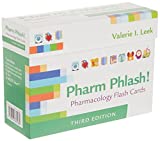
Focus on Pharmacology (8th Edition)
Focus on Nursing Pharmacology makes challenging concepts more approachable. Engaging learning features cultivate your clinical application, critical thinking and patient education capabilities. This updated 8th edition builds on your knowledge of physiology, chemistry and nursing fundamentals to help you conceptualize need-to-know information about each group of drugs.
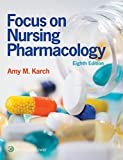
Pharmacology Made Incredibly Easy (Incredibly Easy! Series®)
Nursing pharmacology guide offers step-by-step guidance so you can grasp the fundamentals in enjoyable Incredibly Easy style. This is the perfect supplement to class materials, offering solid preparation for NCLEX® as well as a handy refresher for experienced nurses. Colorfully illustrated chapters offer clear, concise descriptions of crucial nursing pharmacology concepts and procedures.

Lehne’s Pharmacology for Nursing Care (11th Edition)
The Eleventh Edition of Lehne’s Pharmacology for Nursing Care provides a thorough understanding of key drugs and their implications for nursing care. This text, written by renowned nursing educators, helps you comprehend and apply pharmacology principles. A clear and engaging writing style simplifies complex concepts, making even the most challenging pharmacology content enjoyable. We recommend this book if you want a comprehensive nursing pharmacology guide.
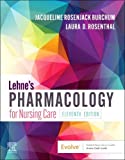
Nursing Drug Handbook
Nursing2023 Drug Handbook delivers evidence-based, nursing-focused drug monographs for nearly 3700 generic, brand-name, and combination drugs. With a tabbed, alphabetical organization and a “New Drugs” section, NDH2023 makes it easy to check drug facts on the spot.
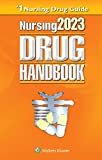
Pharmacology and the Nursing Process
The 10th edition of Pharmacology and the Nursing Process offers practical, user-friendly pharmacology information. The photo atlas contains over 100 unique illustrations and photographs depicting drug administration techniques. Updated drug content reflects the most recent FDA drug approvals, withdrawals, and therapeutic uses.
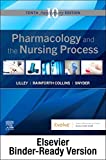
Mosby’s Pharmacology Memory NoteCards: Visual, Mnemonic, and Memory Aids for Nurses
The 6th edition of Mosby’s Pharmacology Memory NoteCards: Visual, Mnemonic, & Memory Aids for Nurses incorporates illustrations and humor to make studying easier and more enjoyable. This unique pharmacology review can be utilized as a spiral-bound notebook or as individual flashcards, making it ideal for mobile study.
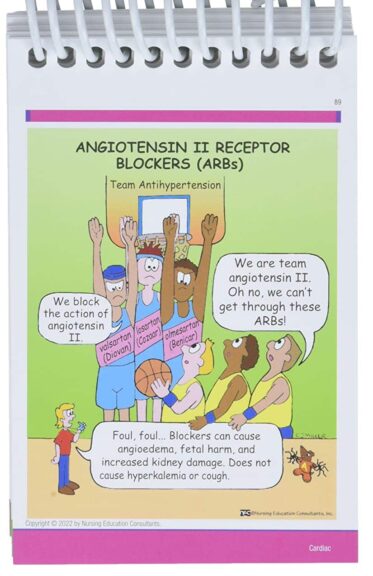
See Also
Here are other nursing pharmacology study guides:
- Nursing Pharmacology – Study Guide for Nurses
Our collection of topics related to nursing pharmacology - Pharmacology Nursing Mnemonics & Tips
These nursing mnemonics aim to simplify the concepts of pharmacology through the use of a simple, concise guide. - Generic Drug Name Stems Cheat Sheet
Learn about these generic drug name stems to help you make sense of drugs easier! - Common Drugs and Their Antidotes
A guide to drug antidotes that nurses should be familiar about. - IV Fluids and Solutions Guide & Cheat Sheet
Get to know the different types of intravenous solutions or IV fluids in this guide and cheat sheet. - Drug Dosage Calculations NCLEX Practice Questions (100+ Items)
Care to take the challenge? This quiz aims to help students and registered nurses alike grasp and master the concepts of medication calculation.
Drug Guides NEW!
Individual drug guides and nursing considerations for the most common medications used in nursing pharmacology:
- Acetaminophen (Tylenol)
- Aspirin
- Atorvastatin (Lipitor)
- Enoxaparin (Lovenox)
- Furosemide (Lasix)
- Gabapentin
- Hydromorphone (Dilaudid)
- Lisinopril
- Metoprolol
- Morphine
Gastrointestinal System Drugs
Respiratory System Drugs
- Antihistamines
- Bronchodilators and Antiasthmatics
- Decongestants
- Expectorants and Mucolytics
- Inhaled Steroids
- Lung Surfactants
Endocrine System Drugs
- Adrenocortical Agents
- Antidiabetic Agents
- Glucose-Elevating Agents
- Hypothalamic Agents
- Insulin
- Parathyroid Agents: Bisphosphonates, Calcitonins
- Pituitary Drugs
- Sulfonylureas
- Thyroid Agents
Autonomic Nervous System Drugs
- Adrenergic Agonists (Sympathomimetics)
- Adrenergic Antagonists (Sympatholytics)
- Anticholinergics (Parasympatholytics)
- Cholinergic Agonists (Parasympathomimetics)
Immune System Drugs
Chemotherapeutic Agents
- Anthelmintics
- Anti-Infective Drugs
- Antibiotics
- Antifungals
- Antineoplastic Agents
- Antiprotozoal Drugs
- Antiviral Drugs
Reproductive System Drugs
Nervous System Drugs
- Antidepressants
- Antiparkinsonism Drugs
- Antiseizure Drugs
- Anxiolytics and Hypnotic Drugs
- General and Local Anesthetics
- Muscle Relaxants
- Narcotics, Narcotic Agonists, and Antimigraine Agents
- Neuromuscular Junction Blocking Agents
- Psychotherapeutic Drugs
Cardiovascular System Drugs
References and Sources
References and sources for this pharmacology guide for Parathyroid Agents:
- Karch, A. M., & Karch. (2011). Focus on nursing pharmacology. Wolters Kluwer Health/Lippincott Williams & Wilkins. [Link]
- Katzung, B. G. (2017). Basic and clinical pharmacology. McGraw-Hill Education.
- Lehne, R. A., Moore, L. A., Crosby, L. J., & Hamilton, D. B. (2004). Pharmacology for nursing care.
- Smeltzer, S. C., & Bare, B. G. (1992). Brunner & Suddarth’s textbook of medical-surgical nursing. Philadelphia: JB Lippincott.
